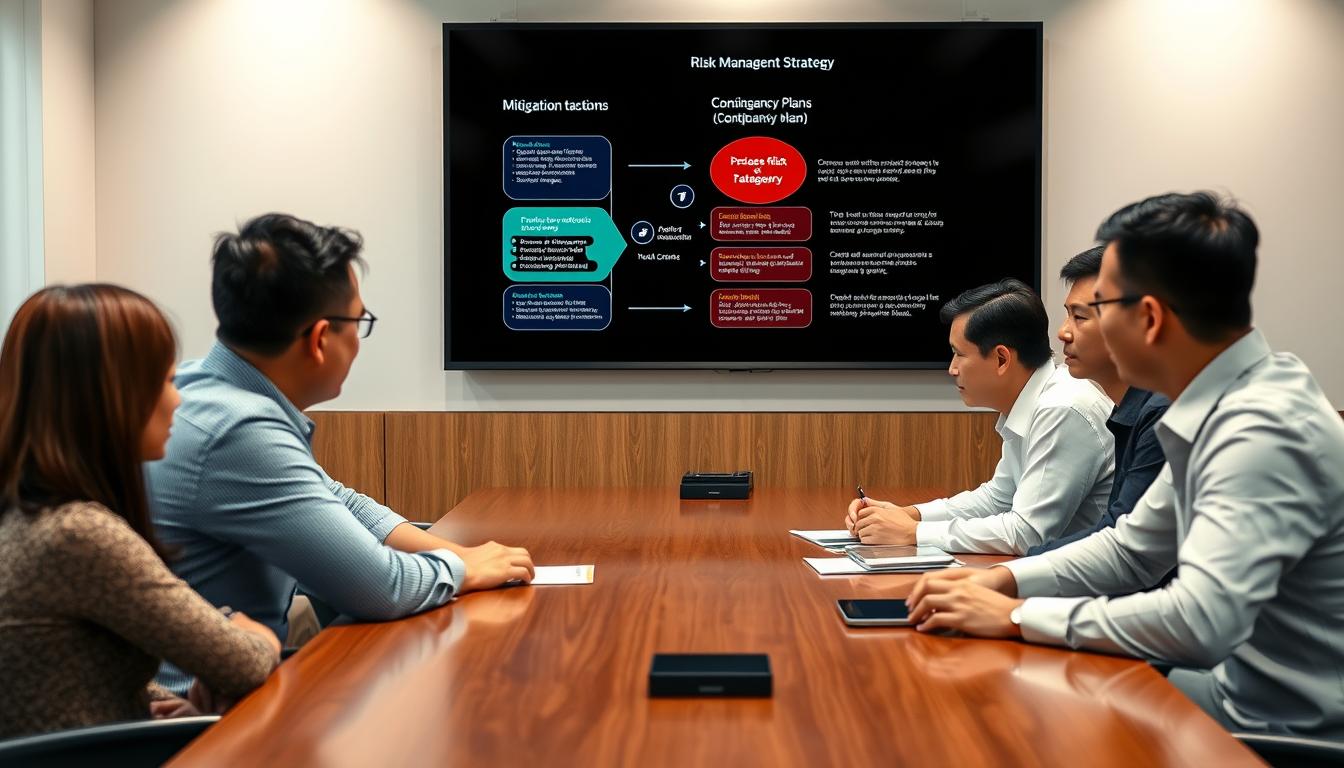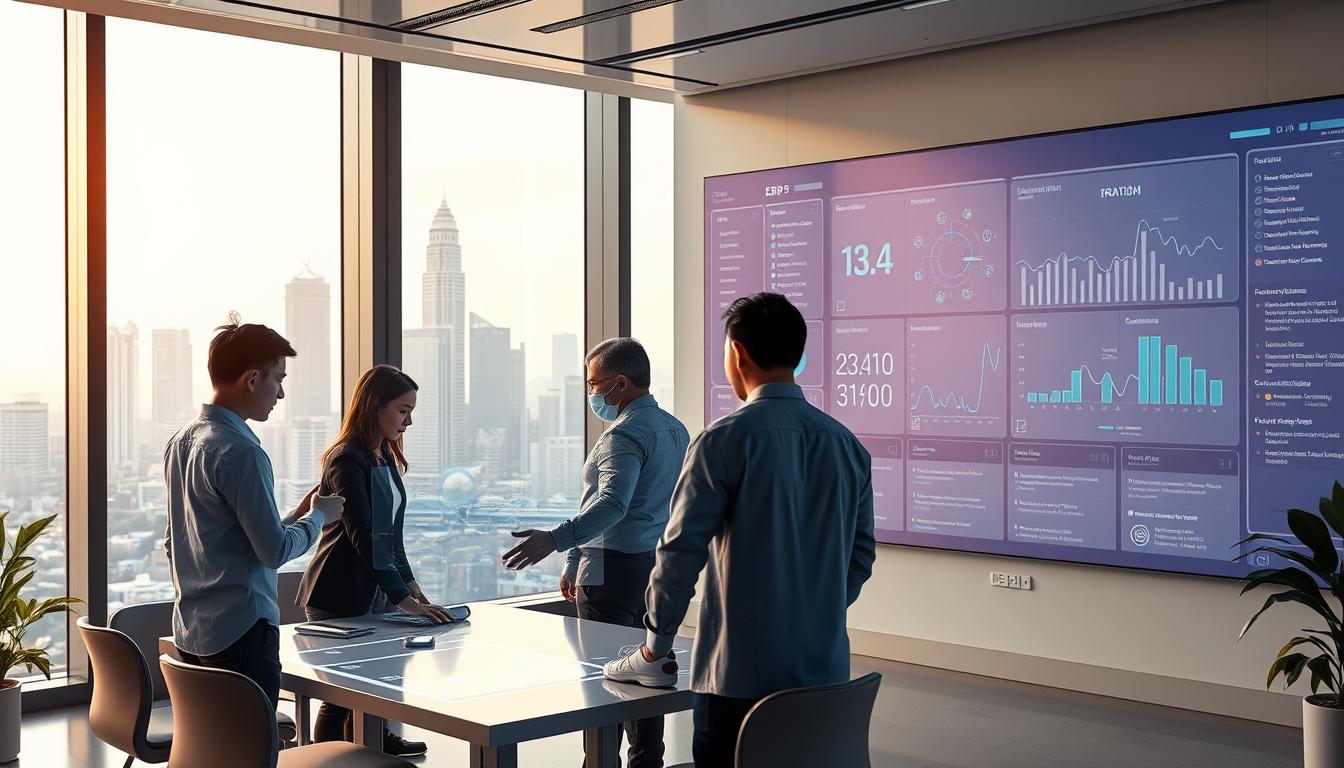Ever wondered why some businesses do great with ERP systems while others face constant problems? It often comes down to how they plan for the future. A proactive approach to ERP system issues is key. For small and medium enterprises in the Philippines, taking steps to handle potential problems can greatly improve efficiency.
Understanding ERP systems and taking steps to lower failure risks can protect investments. It also makes systems more user-friendly and satisfying.
Key Takeaways
- Identifying potential ERP system issues early can lead to effective solutions.
- Proactive support helps maintain operational efficiency and reduces downtime.
- Strategic planning is essential for future prevention of system failures.
- Training staff is crucial in minimizing risks associated with ERP systems.
- Regular audits can catch problems before they escalate into major issues.
- Open communication fosters a culture of continuous improvement.
Understanding ERP Systems and Their Challenges
ERP systems are all-in-one solutions that help businesses manage their data. They make sure all parts of the company work together smoothly. For small and mid-sized businesses in the Philippines, it’s key to know the challenges of ERP systems to improve efficiency.
Businesses often struggle to connect different parts of their operations. This can cause problems like data silos and communication issues. Keeping data accurate is also a big challenge, as mistakes can harm decision-making. Getting employees to use the new system can also be tough without proper training.
Knowing these challenges helps businesses find the right solutions for their needs. By tackling these issues early on, companies can use ERP systems to boost their productivity and performance.
| Challenge | Description | Potential Impact |
|---|---|---|
| Integration Issues | Difficulty in merging different business functions within the ERP system | Leads to data silos and reduced collaboration |
| Data Accuracy | Risk of inaccuracies in data input and processing | Compromises decision-making and reporting |
| User Adoption | Lack of training may cause resistance among employees | Impacts overall system utilization and efficiency |
Prioritizing User Training for ERP Success
Effective user training is key to ERP success. Companies often overlook how important good training is. A solid training program makes users skilled and confident.
This leads to fewer mistakes and a smoother transition. It makes using the system easier.
The Importance of Thorough Training
Good training is crucial to avoid ERP risks. When employees are well-trained, they do their jobs better. This boosts productivity.
In the Philippines, small to medium enterprises can get tailored training. This helps employees understand their tools better. Customized programs boost confidence in using the system.
Regular Refresher Courses for System Adaptation
Regular refresher courses keep employees updated. As technology changes, learning must keep up. These courses keep users engaged and reinforce key concepts.
Companies that focus on ongoing training show they care about their employees. They are committed to ERP success. Resources like effective HR training help support learning at work.
Regular Audits: A Health Check for Your ERP
Regular audits are key to keeping your ERP system healthy. They help spot problems before they get big. These checks make sure data is right, look at who’s using the system, and check how things work.
Having a set schedule for audits makes everyone more careful with their work. It encourages users to enter data correctly and follow rules. This helps keep the system running smoothly.
In the Philippines, this method helps find issues early. It builds a culture of openness and high standards. Regular checks also make sure your system meets all the rules.
| Audit Aspect | Purpose | Benefits |
|---|---|---|
| Data Accuracy Verification | Ensure information integrity | Minimize errors in reports |
| User Activity Review | Monitor compliance and usage | Enhance accountability |
| Operational Process Analysis | Identify inefficiencies | Improve workflow performance |
Regular audits are the start of making your ERP system better. They find and fix problems. This lets teams work their best and meet business goals.
Keeping Your ERP System Updated
In today’s fast-paced world, ERP system updates are key. They keep your system safe and running well. Updates add new security features and improve how you manage data and workflows.
Critical Software Updates for Security
Applying critical patches on time is vital. It stops hackers from getting in. Without updates, your system can be hacked, leading to lost data and a bad reputation.
It’s important to have a plan for updating your ERP system. This way, you stay ahead of security threats instead of just reacting to them.
Enhancing Functionality Through Regular Patches
Updates do more than fix problems. They also make your system work better and add new features. These changes can make your processes smoother, improve user happiness, and help you make better decisions.
By keeping your ERP system up to date, you stay competitive. You also ensure your operations run smoothly and reliably.
Importance of Data Backups for Business Continuity
Keeping your business running smoothly depends on good data management. Having a solid backup plan is key. It helps protect your data and makes recovery quick if something goes wrong.
Routine Backup Schedules
Every business needs a plan for regular backups. This keeps your important data safe. By backing up daily or weekly, you can avoid losing critical information during emergencies.
Testing Backup Systems to Ensure Data Integrity
It’s also crucial to test your backup systems often. This makes sure your data can be recovered when needed. For companies in the Philippines, this is even more important. It helps keep your business running smoothly.
Implementing a Solid Risk Management Strategy
A good risk management strategy is key for any business to protect its ERP systems. In today’s fast world, spotting risks early is very important. Companies need to know the threats and plan well.
Identifying Risks and Their Impact
Businesses should look for risks that could harm their ERP systems. Risks like data breaches, system failures, and integration problems are common. These can cause small problems or big financial losses.
Understanding these risks helps companies take action before they happen. This way, they can manage risks better.
Creating Contingency Plans for Various Scenarios
After finding risks, the next step is to make plans for different situations. These plans should cover quick actions, how to use resources, and how to communicate. Having clear plans helps react fast to unexpected problems.
| Risk Type | Potential Impact | Contingency Plan |
|---|---|---|
| Data Breach | Loss of sensitive information and reputational damage | Implement robust security measures and response protocols |
| System Downtime | Operational disruptions and revenue loss | Establish a backup system and recovery procedures |
| Integration Failings | Reduced efficiency and productivity | Regular testing and system checks prior to updates |
By focusing on risk management, companies can get better at facing challenges. This careful planning helps protect ERP systems and makes operations better.
Encouraging User Feedback for System Improvement
Gathering user feedback is key to better ERP systems. Users face daily challenges and share valuable insights. A supportive atmosphere encourages open communication, letting users share freely.
This approach creates a team environment where everyone feels heard. It shows that their opinions count in making decisions.
Creating a Culture of Open Communication
Organizations need to foster an open communication culture. Regular feedback sessions and anonymous surveys help users share their thoughts. This shows leaders care about user experiences.
Such efforts lead to big improvements in system functionality. It’s a step towards making systems better for everyone.
Tracking and Implementing User Suggestions
It’s important to track and analyze user feedback systematically. A clear framework for evaluating feedback ensures changes are made. Documenting feedback and acting on user suggestions boosts system functionality and user satisfaction.
In the Philippines, a diverse SME landscape benefits from stakeholder participation. This collaboration is crucial for improvement.
Post-Implementation Support: Ensuring Long-Term Success
Post-implementation support is key to keeping an ERP system running smoothly. It helps organizations face new challenges and adapt to changing needs. This support ensures users feel confident and helps the system meet business goals.
Creating a strong support system keeps the ERP stable and boosts productivity. In the Philippines, many companies see ERP success as a journey, not just a one-time event. They focus on ongoing support and adaptation for lasting success.
| Support Feature | Benefits | Impact on Long-Term Success |
|---|---|---|
| Help Desk Services | Instant issue resolution and guidance | Higher user satisfaction and productivity |
| System Updates | Access to the latest features and security measures | Improved system performance and protection |
| Training Sessions | Enhanced user skills and confidence | Better alignment with evolving business processes |
| Feedback Mechanism | Opportunities for user input and system enhancement | Cultivates a sense of ownership and commitment |
Real-life Examples of ERP Failures and Lessons Learned
Learning from ERP failures is crucial for businesses. Real-life examples show common mistakes that can cause big problems. For example, Nike’s ERP failure in 2000 was due to not testing their supply chain software well enough.
This mistake led to inventory problems and a drop in sales. Businesses can learn from this to make sure they test everything well and set realistic goals.
National Grid’s ERP rollout also went wrong. The integration with existing systems was poor, causing delays and extra costs. This shows the need for a detailed plan that covers all systems involved.
Using these examples, small and medium enterprises (SMEs) in the Philippines can learn how to avoid similar mistakes. They can develop better strategies for their ERP systems.
Leveraging New Technologies and Automation
Using new technologies and automation can make ERP systems work better. Tools like artificial intelligence and machine learning help SMEs in the Philippines a lot. They make it easier to make smart decisions and keep up with market changes.
Staying ahead in the market is simpler with these tools. Automation cuts down on manual work, making things more efficient and less prone to mistakes. This leads to better processes and keeps ERP systems up to date.
By embracing these advancements, businesses can tackle ERP challenges head-on. This ensures they stay flexible in a fast-changing world.
Involving Stakeholders in the ERP Process
Getting stakeholders involved in the ERP process is key to success. It’s important to engage key users from different areas of the business. This helps identify specific needs and boosts user involvement.
This teamwork approach makes everyone feel more connected to the ERP system. It ensures the system meets the organization’s needs well.
Stakeholder involvement helps reduce resistance to change. Early input from users helps spot and solve problems before they start. This makes the transition smoother and improves the ERP system’s performance.
For small and medium enterprises in the Philippines, successful outcomes rely on stakeholder involvement. A well-run ERP process with active stakeholder participation leads to better productivity and efficiency.
Setting Realistic Expectations for ERP Implementation
Setting realistic goals for ERP implementation is key to saving money and avoiding disappointment. It’s important to clearly outline what needs to be done, when, and what will be achieved. Talking to all involved early on helps everyone understand what’s expected.
Good project management means keeping the lines of communication open. This way, businesses can tackle issues, adjust to new needs, and lower risks. Keeping users informed and happy is crucial for a smooth ERP launch.
In today’s fast-changing business world, having realistic goals is not just about success. It’s also about planning for the future. Here are key elements for a successful ERP rollout:
| Component | Description |
|---|---|
| Clear Objectives | Establish what the ERP system should achieve based on organizational needs. |
| Defined Timelines | Set milestones and deadlines to track progress effectively. |
| Stakeholder Involvement | Engage all relevant parties in the planning and feedback processes. |
| Regular Communication | Maintain consistent updates to keep everyone informed and aligned. |
| Adaptability | Be prepared to address unforeseen challenges and pivot as necessary. |
Conclusion
Ensuring ERP system success is key for small and medium-sized enterprises in the Philippines. Investing in user training, updates, and audits is crucial. These steps help solve problems now and prevent them in the future.
Creating a user-friendly environment helps companies meet changing market needs. By listening to feedback and using user ideas, systems can get better. This leads to more efficiency and productivity.
Being proactive sets the stage for long-term ERP success. It builds a strong base for future challenges. By focusing on these practices, businesses can look forward to a brighter future.
FAQ
What common challenges do SMEs face with ERP systems?
SMEs often struggle with integrating different business functions. They also face issues with data accuracy and getting users to adopt the system. Understanding these challenges is key to improving efficiency and tailoring solutions for specific needs.
Why is user training important for ERP success?
User training is vital because it boosts user skills and cuts down on mistakes. Good training covers all system modules and includes regular updates. This keeps users engaged and helps the system stay effective.
How can regular audits help my ERP system?
Regular audits find problems early, before they get worse. They check data accuracy, review user actions, and look at how things work. This ensures everything runs smoothly and promotes a culture of excellence.
Why should I keep my ERP system updated?
Updates fix bugs and add new features that make the system better. Keeping up with updates keeps things running smoothly, improves user experience, and keeps data safe.
What are the best practices for data backups?
Make sure to back up data regularly and test your recovery systems. This creates a reliable backup plan. It helps you quickly recover from problems and keeps important data safe from loss or cyber threats.
How do I implement a risk management strategy for my ERP system?
First, identify risks like data breaches and system failures. Then, figure out how they could affect you and plan for them. This makes your ERP system more resilient and helps you handle unexpected problems better.
Why is user feedback important for ERP enhancement?
User feedback is key because it helps solve problems quickly. Users often spot issues first. By listening to them, you can make the system better and keep users happy.
What is the significance of post-implementation support?
Post-implementation support is crucial for fixing ongoing issues and adapting to new needs. It ensures your ERP system stays stable and meets your business goals over time.
What can we learn from real-life ERP failures?
Looking at ERP failures shows the importance of good training, realistic goals, and thorough testing before going live. These lessons help SMEs plan better and manage resources wisely.
How can new technologies enhance ERP systems?
New tech like AI and machine learning can make processes smoother, improve decision-making, and boost ERP efficiency. This gives SMEs a competitive edge in the market.
Why is stakeholder involvement crucial in the ERP process?
Getting stakeholders involved ensures everyone is on board and helps with smooth transitions. It encourages teamwork, reduces resistance to change, and makes sure the ERP system meets user needs.
How do I set realistic expectations for ERP implementation?
Clearly define what you want to achieve, when, and what you’ll get. Keep talking to everyone involved. This helps avoid problems and keeps users happy during the ERP rollout.



